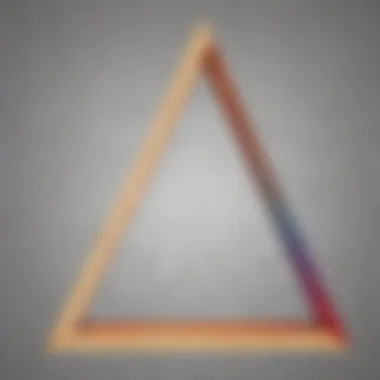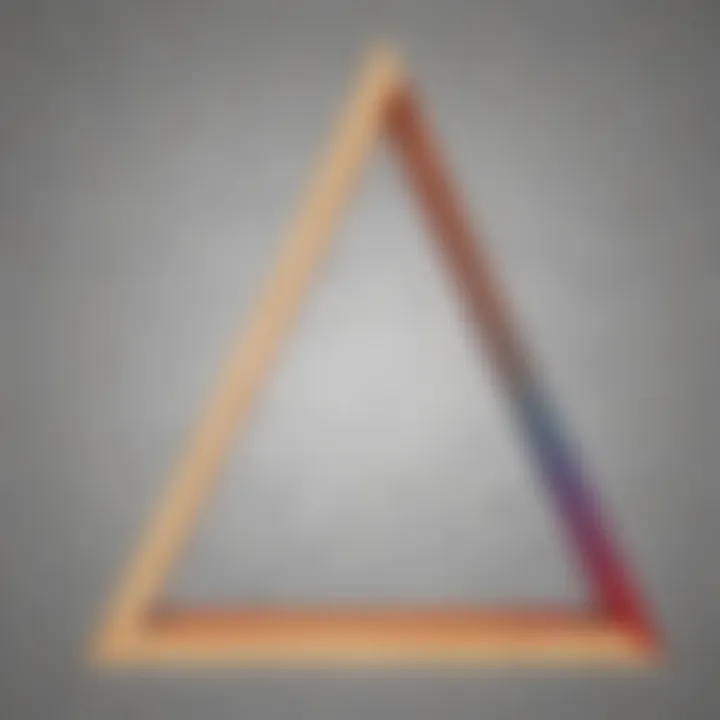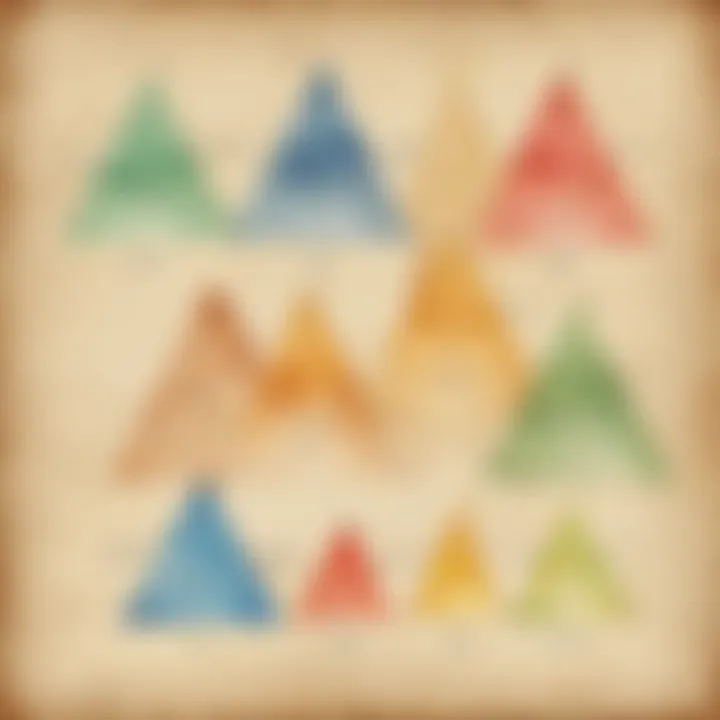Exploring Triangle Area Calculation Techniques


Intro
Calculating the area of a triangle isn't just a task for math enthusiasts; it's a fundamental part of geometry that unlocks a whole new world for curious young minds. Triangles are everywhere, from the rooftops we see in our neighborhoods to the tiny slices of pizza waiting for us at lunch. Understanding how to find the area of these shapes challenges kids to think critically and apply what they've learned in skills that follow them into real life.
This guide is crafted to make the topic of area calculation approachable. By exploring different formulas and diving into practical examples, we aim to strip away the complexities often associated with geometry and help elementary school children grasp these ideas without feeling overwhelmed.
In the following sections, readers will discover not just the mathematics behind area measurement but also creative activities that encourage hands-on learning, quizzes to solidify understanding, and fact-driven content that satisfies the innate curiosity kids have about the world around them.
Let’s jump right in!
Intro to Triangles
Triangles play a pivotal role in geometry and real-world applications. They are one of the simplest shapes, yet they form the building blocks of more complex geometric figures. Understanding the basic properties of triangles sets the foundation for grasping the methods used in calculating their area, which is fundamental in both mathematics and practical scenarios like construction and design.
What makes triangles interesting is their versatility. They appear in various fields such as architecture, art, and engineering. By delving into the world of triangles, students and learners not only sharpen their mathematical skills but also gain insights into how these shapes can resolve real-life problems, ranging from measuring land to designing structures.
The importance of talking about triangles doesn’t just lie in academic learning. It’s about recognizing how these shapes can encode information, build strength in structures, and foster problem-solving skills in young learners. Understanding triangles is a stepping stone for grasping more complex geometric ideas and calculations, paving the way for deeper learning in mathematics.
What is a Triangle?
A triangle is a three-sided polygon characterized by its three edges and three vertices. The simplest of geometric figures, it can vary in shape and size but always maintains the same basic structural properties. A triangle’s sides meet at angles that can come together to form a sum of 180 degrees. But there’s more beneath the surface!
Triangles can be categorized based on side lengths and internal angles, leading to a fascinating exploration of shapes. This variety will assist students in developing critical thinking skills as they encounter different types of triangles in nature and practical applications.
Types of Triangles
Triangles are broadly classified into four major types, each with its unique characteristics that contribute to understanding their area and properties.
Equilateral Triangles
Equilateral triangles are unique because all three sides are equal in length, and each internal angle measures 60 degrees. This symmetry is not just for aesthetics; it helps in calculations as well. When it comes to calculating the area of an equilateral triangle, the formula involves straightforward steps, making it a popular choice for learners.
One unique feature of equilateral triangles is their ability to demonstrate the concept of symmetry. This feature often leads to significant simplifications in geometry problems and proofs. However, they may limit certain real-world applications due to their restrictive angles and side lengths.
Isosceles Triangles
Isosceles triangles have two sides of equal length, which lends itself to a variety of fascinating properties. The angles opposite the equal sides are also equal, establishing a sort of balance in the shape. This key characteristic offers students a visual representation of symmetry, often encountered in nature and design.
A unique feature of isosceles triangles is their applicability in construction, as they provide substantial structural support. However, their less versatile nature compared to scalene or right triangles means they might not be as frequently used in diverse applications.
Scalene Triangles
Scalene triangles are defined by having all sides of different lengths and angles of different measures. This variety adds to the complexity of its area calculation but also makes scalene triangles a great study for learners looking to understand triangles with a specific approach.
The advantage of scalene triangles is their generality. They fit into a wide range of scenarios but this can make calculations slightly more challenging. A savvy learner can discover how to navigate these complexities while still solidifying their geometry skills.
Right Triangles
Right triangles are notable for having one angle that measures exactly 90 degrees. This characteristic leads to various practical applications, especially in fields such as architecture and engineering. The Pythagorean theorem applies here, making calculations straightforward and manageable.
Their unique feature, the right angle, makes these triangles highly useful in real-world scenarios, especially where measurements need to be precise. As one of the most studied triangle types, right triangles prepare learners for a broader understanding of mathematical principles and applications.


Importance of Understanding Area
Understanding the area of triangles is crucial for grasping broader mathematical concepts. It’s not merely about numbers; it’s about visualizing space and function. In learned discussions, the area of triangles can be a gateway to further exploration in geometry and measurements. Knowing how to calculate the area paves the way for engaging in intricate projects, whether in school or home activities.
Additionally, grasping the concept of area helps students apply their knowledge practically. They learn to assess land for gardening projects, devise architecture-like models, or even create art pieces with geometric shapes. Therefore, comprehending triangles and their areas serves as a foundational skill in both academic and everyday problem-solving.
"Geometry is not only a subject—it's a glimpse into the very fabric of shapes that surround us every day."
Understanding the fundamentals of triangles results in a better comprehension of spatial relationships, which are vital in many fields and everyday contexts.
Basic Properties of Triangles
When diving deeper into the mathematics of triangles, understanding their basic properties is key. It sets the stage for everything that follows, from calculating their area to applying these concepts in real-world scenarios. Triangles are not just shapes; they are foundational elements in geometry that connect various mathematical principles.
Vertices, Edges, and Angles
A triangle is defined by its vertices, edges, and angles. These three components are like the backbone of triangled geometry.
- Vertices: A triangle has three corners or vertices. Think of them as the triangle's points of interest. For instance, in a triangle named ABC, A, B, and C are the vertices. Each vertex represents a meeting point of two sides.
- Edges: The edges or sides of the triangle are the lines connecting the vertices. A triangle has three edges. These edges have lengths that significantly impact the triangle's shape and area. It's important to remember that different triangles have different side lengths and types.
- Angles: Each triangle has three angles, formed where the edges meet. The sum of these angles always equals 180 degrees. This simple yet vital rule applies to all triangles, whether they are flat on paper or standing out in a design template.
Understanding how these elements work together helps in grasping the larger picture of triangles. For instance, the angles provide insight into the triangle’s classification—think of equilateral, isosceles, and scalene types. Knowing how to measure angles contributes enormously in calculating area, making this section not just fundamental but practically essential.
The Triangle Inequality Theorem
The Triangle Inequality Theorem might sound daunting at first, but it's pretty simple. This theorem states that for any triangle, the sum of the lengths of any two sides must be greater than the length of the remaining side. This is critical when trying to determine if a set of three lengths can actually form a triangle.
- If you take two sides, say 4 cm and 5 cm, their combined length is 9 cm. This must always be greater than the third side’s length—in this case, any side longer than 9 cm would not work.
- This theorem acts as a gatekeeper, ensuring satisfying triangles can exist in a given framework, aiding not just in finding areas but also ensuring structural integrity in designs or constructions.
"The essence of triangle formation becomes clearer with the Triangle Inequality Theorem, allowing novices and experts alike to feel the constraints of the shape's practical limitations."
Understanding Perimeter vs. Area
Perimeter and area are two essential concepts in the realm of triangles, yet they represent different ideas. Understanding their distinction is vital for anyone looking to explore area calculation successfully.
- Perimeter: This term refers to the total distance around the triangle. To find it, just add up the lengths of all three edges. For example, if the sides of a triangle are 3 cm, 4 cm, and 5 cm, then the perimeter is 12 cm (3 + 4 + 5). It's simply an expression of how far you would have to walk to go around the triangle’s outline.
- Area: On the flip side, the area represents the space contained within the triangle’s boundaries. Think of it as how much carpet you'd need to cover the floor of a triangular room. For basic calculations, the area can be found by using the formula:This shows how the base and height work together to express the size of the triangle in two dimensions. In simpler terms, while the perimeter gives you a notion of the triangle's outer limits, the area illustrates the space it occupies.
As you can see, both perimeter and area play critical roles in the practical applications of triangles, particularly in geometry where clear measurements are key. Understanding these properties lays the groundwork for more advanced discussions on calculating area.
Formulas for Area Calculation
In the world of geometry, calculating the area of a triangle stands as a fundamental skill. This section sheds light on the various formulas used for area calculation, emphasizing their importance in both academic settings and real-life applications. By grasping these formulas, learners can develop a significant understanding of spatial relationships and the properties of triangles. Moreover, recognizing the context in which different formulas apply helps students choose the most efficient method for their needs.
The Basic Formula: A = / × base × height
The basic formula for the area of a triangle is a cornerstone in geometry. This can be expressed as A = 1/2 × base × height. So, what does this mean? Essentially, the formula conveys that to calculate the area, one must first identify the base of the triangle and its corresponding height. The base can be any side of the triangle, while the height is the perpendicular distance from that base to the opposite vertex.
- Why it matters: This formula forms the basis for introductory lessons in geometry. Understanding this aligns with grasping how triangles occupy space in a two-dimensional plane.
- Application: An example can be seen in determining the area of a triangular garden patch. If the base measures 10 meters and the height is 6 meters, the area calculates to A = 1/2 × 10 × 6 = 30 square meters. Simple, right?
Using Heron's Formula
When dealing with triangles where height is not readily available, Heron's Formula swoops in like a superhero of area calculation. This formula allows for finding the area based solely on the lengths of each side of the triangle, making it particularly useful when the height isn't easy to measure.


Derivation of Heron's Formula
Heron's formula emerges from a clever play on half-perimeter, which is the semi-perimeter of the triangle. (s = (a + b + c) / 2) gives us the semi-perimeter where (a), (b), and (c) are the sides. The area can be calculated using the expression:
- Key characteristic: This formula is a favorite because it allows calculations without needing the height of the triangle. It’s a great fit for more complex triangle shapes.
- Unique feature: It can handle any triangle shape— from scalene to isosceles, opening doors to various practical situations.
Practical Application of Heron's Formula
The practicality of Heron's Formula shines through in fields like land surveying and architecture. It allows professionals to assess land areas or material requirements when dealing with irregular lots.
- Why it stands out: Heron's formula provides a straightforward approach when traditional measurement tools like heights aren't accessible, saving the day in tricky situations.
- Advantages: Particularly advantageous for large, land-based applications, it adjusts well to real-world complexities in design and construction.
Area Calculation of Special Triangles
Triangles come in various shapes and sizes. Each type has its own quirks, and the area calculation methods reflect that.
Area of an Equilateral Triangle
Equilateral triangles are special as all sides are of equal length, leading to a unique formula for calculating their area: [ A = (√3/4) × a^2 ] where (a) is the length of a side.
- Key aspect: Recognizing that all sides are the same presents a straightforward calculation, making it easy for young learners to master.
- Benefits: Primarily useful in design applications like creating equitable land plots or uniform roofing styles, making the area calculation not only educational but also applicable in real life.
Area of a Right Triangle
The right triangle harnesses the beauty of the Pythagorean theorem but still sticks to our earlier basic formula for area, given its direct relationship between base and height.
- Significance: Right triangles frequently appear in various fields, from architecture to everyday problem-solving. Knowing how to calculate its area can open doors for students as they advance in math.
- Unique feature: Right triangles are often simpler to visualize and work with due to their right-angle, making them more approachable for beginners in geometry.
Practical Applications
Understanding how to calculate the area of a triangle extends beyond mere classroom exercises. It's about grasping the real-world implications of geometry, which can seem daunting but bear yields that support various activities and professions. The practical applications of triangle area calculation make learning about shapes not only relevant but also essential. Consider how architects and land surveyors rely on such calculations to make informed decisions.
Real-Life Examples
Construction and Design
When it comes to construction and design, calculating the area of a triangle plays a vital role. Many structures, from rooftops to bridges, often employ triangular forms due to their strength and stability. For instance, the roof of a house, commonly shaped like a triangle, needs accurate area calculations to determine the amount of materials required. By calculating area, builders understand how much roofing material they need, reducing waste and ensuring a good fit.
A key characteristic of using triangles in construction is their inherent stability. Unlike shapes with more sides, a triangle cannot deform without changing the length of at least one side. This makes triangles a popular choice in engineering designs. However, the downside can be the complexity of some designs that involve multiple triangle shapes
Unique features such as the ability to reinforce structures with fewer materials make triangle-based designs a lean and efficient method. Yet, one must note that understanding the area requires a solid foundation in geometry, which can present challenges, particularly for those unfamiliar with such principles.
Land Measurement
Land measurement is another area where the calculation of triangle area is crucial. Surveyors often use triangular calculations to determine the area of plots, especially when dealing with irregularly shaped land. This information is essential for property sales, agricultural planning, and even planning urban developments. When a surveyor needs to determine the area of a triangular plot, they can utilize the base and height to figure out just how much land is available.
A defining characteristic of measuring land with triangles is its versatility. Triangles can easily adapt to any space, providing an effective method for assessing land measurements. Using triangles in this context is beneficial because it allows surveyors to break down complex sites into manageable sections, simplifying calculations.
However, there are considerations. The angles and lengths must be accurately measured, as small errors can lead to significant discrepancies. For example, a miscalculation could result in an underestimation of land area, potentially impacting property values.
Using Area in Problem Solving


The skills involved in calculating triangle area often lead to enhanced problem-solving abilities. For instance, when students learn to determine the area of a triangle, they cultivate a mindset that can apply to varied situations, whether it’s calculating the amount of paint needed for a triangular wall or determining how much land can be cultivated using triangular plots. This practical knowledge empowers children to approach problems with confidence and accuracy.
"Understanding the area of simple shapes like triangles helps students build a foundation for tackling more complex geometric concepts later on."
By anchoring lessons in real-life applications, students can better grasp why these principles matter, setting the stage for further exploration in both math and architectural domains.
Visual Understanding through Diagrams
Visual representations play a crucial role when it comes to grasping the concept of calculating the area of a triangle. For elementary school children and those supporting their learning, diagrams can turn seemingly abstract ideas into tangible images, making the material more approachable. When kids see a triangle laid out clearly with its base and height marked, they begin to piece together how to apply formulas in real life. This visual context is not just beneficial; it’s essential for driving home the point that geometry isn’t just about numbers—it’s also about shapes and spaces.
Another significant advantage of using visuals is that they can create a bridge between understanding and memorization. Instead of merely rote-learning formulas, children can visualize how those formulas derive from a triangle's properties. Each triangle can have a different area based on its dimensions, and diagrams help illustrate these variations effectively.
There are several considerations to keep in mind while using diagrams:
- Clarity: The diagram must be clear and simple enough for children to comprehend at a glance.
- Relevance: Diagrams should focus specifically on illustrating area calculation, avoiding unrelated elements that might confuse the learner.
- Engagement: Using colorful and engaging illustrations can capture a child’s interest more than black-and-white text ever could.
Taking these aspects into account will not only help children understand areas more effectively but also encourage an enduring interest in mathematics.
Illustrating the Concept
When we talk about illustrating the concept of area in triangles, we often refer to the basic triangle area formula: A = 1/2 × base × height. To bring this concept to life, it’s helpful to show children a triangle with its base horizontally laid out, while a straight dashed line rises from the base to the top vertex, indicating the height. Such visual aids help demonstrate that the area is half the product of the base and height.
Using different colored sections to fill the triangle can further assist learners in visualizing how the area changes with different dimensions. A bright red triangle contrasting against a light yellow area can make the calculation process feel more engaging. Hand-drawn or digitally created diagrams can be equally effective, but kids must find them relatable.
Visual Tools for Learning
There are various tools that cater specifically to learning through visuals. Some of these include:
- Interactive Geometry Software: Programs like GeoGebra allow students to create their own triangles and observe how changing the dimensions affects the area in real time. This hands-on approach cultivates exploration and curiosity.
- Graphing Paper: Children can draw triangles on graph paper and count the squares to understand how area works practically. This not only cements the idea of area but also improves spatial reasoning skills.
- Mobile Apps: There are several educational apps available that focus on geometry. Some might even incorporate games or challenges that require calculating areas to progress, making learning feel like play.
"Visualizing math isn’t just about making it fun; it’s about making it meaningful."
By incorporating tools and methods that emphasize visual learning, children can develop a deeper understanding of triangles and their areas. The journey through these concepts can transform confusion into clarity, helping them grasp principles that last a lifetime.
End
In wrapping up our exploration of triangle area calculations, it’s crucial to highlight the significance of the knowledge gained. This article has not just been a series of mathematical formulas. Rather, it has opened a window into the depth and application of geometry in everyday life. Understanding how to calculate the area of a triangle has practical importance. From designing structures to measuring parcels of land, these principles have real-world relevance.
When it comes to learning, grasping the concept of area is foundational. It helps in developing spatial awareness, which is essential not only in mathematics but in various fields. Students can appreciate how triangles fit into larger geometric discussions and practical situations.
"The beauty of mathematics is not just in numbers, but in how they relate to the world around us."
This notion leads to an important takeaway: the skills and knowledge of area calculations can foster critical thinking and problem-solving abilities. By methodically breaking down each step, from using basic formulas to applying Heron's formula, learners can develop confidence in their mathematical capabilities.
Recap and Key Takeaways
- Understanding: Area calculations for triangles aren’t just about memorizing formulas. They require a clear grasp of concepts like base and height, especially when dealing with different types of triangles.
- Practical Applications: The principles gained here extend beyond math class and permeate daily life, such as in
- Diverse Formulas: We explored various methods for area calculation including the basic formula for right triangles and Heron's formula for others. This variety equips enthusiasts with tools suitable for various problems.
- Construction projects, where planning and space measurement are crucial.
- Landscape design, where area is needed to lay out gardens or playgrounds.
Encouraging Further Exploration
Learning doesn’t have to stop here. Now that the foundational principles are laid out, there’s a world of intricate geometry waiting to be uncovered. Delve into more complex shapes like quadrilaterals or circles. Visit resources like Wikipedia for in-depth explanations or check discussions on Reddit about geometric puzzles and their solutions.
Parents and educators can play a vital role by encouraging hands-on activities. For instance, do some measuring and calculating outdoors. Think of the area of the backyard or a space for a new tree.
Encouraging curiosity in mathematics paves the way for a future where students become learners for life. With every step into further knowledge, they contribute to a more informed society. So gather those triangles and start exploring!







